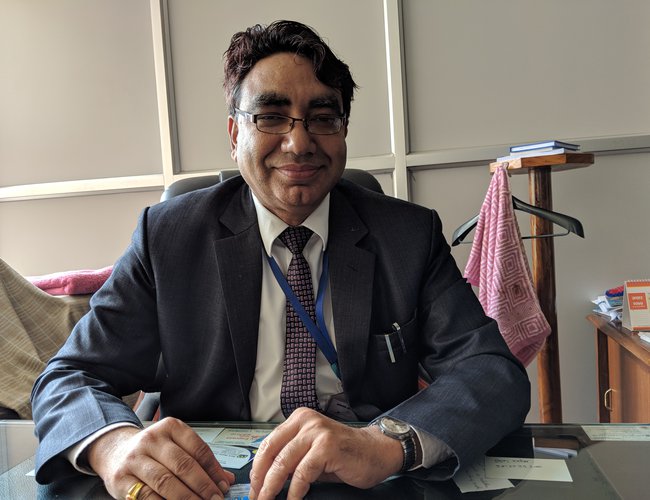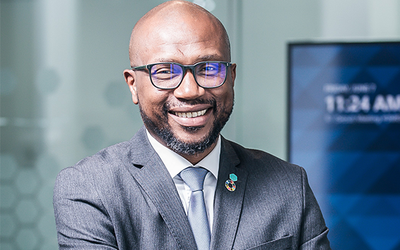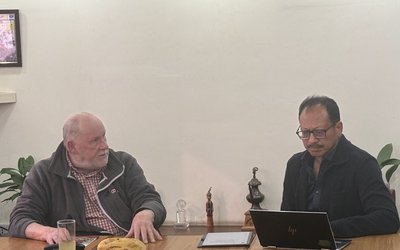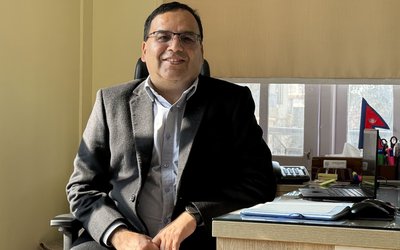
With the restructuring of the state into three tiers, Central, Provincial and Local levels, the functions of the Department of Water Supply and Sewerage (DWSS) have also transformed. With his long experience in the water supply and sanitation sector, Director General of DWSS Tej Raj Bhatta spoke to New Spotlight on issues related with the transformation.
After the restructuring of Nepal’s politics, what is the state of the structures of the DWSS?
As the political structure has changed, we have also changed our structures to meet the new requirements. Currently, under the Ministry of Water Supply, the DWSS is there at the central level. We have proposed seven provincial offices under the DWSS. These provincial level offices will implement the programs and projects of the center aimed at meeting the target set by the Social Development Goals in the areas of water and sanitation. The provincial level offices will also work to fulfill the fundamental rights of the constitution on water and sanitation. Under the DWSS, these provincial level offices also implement big central projects in the provinces and local levels. They will implement the projects of national interest and interstate projects, under the guidance of DWSS. The central office will implement the bigger projects, be they related to drinking water or sewerage. However, the provincial governments will implement the medium level projects and local level will implement smaller projects.
What is the process of transformation like?
For now, we have allocated the budget for all 75 districts. We are now discussing whether the 28 divisions should be retained? After the completion of the current and ongoing projects, DWSS will hand over the asset to the local government. However, operational parts will be taken by user groups or utility operators. They may be boards, private companies or community based groups. We have drafted the guidelines.
As Nepal has made a big progress in the drinking water and sanitation sector over the last 15 years, what steps is the DWSS taking to sustain the achievements?
To sustain our achievements, we are going to hand over our entire system to the local or provincial levels. We will hand over the central ownership to the center down to the local level as per the constitutional provisions. As all the institutions will remain intact, nothing will drastically change. They will carry on their work.
New responsibility of the three tires of governments will be there. However, we will carry out the projects and programs, coordinating with provinces and local levels.
What are the major challenges?
Investment is a big challenge for the sector to meet as per the goal set by the Social Development Goals. Currently, almost 87 percent of the population has access to drinking water. Some old projects, which have been supplying water, are now facing problems in the sources of water and some have problems in management. There is the need to renovate some projects because of the age. Still 13 percent of the population does not have access to water and we need to cover this chunk. As per the target set by the Social Development Goals (SDG), we have to supply safe and pure drinking water to 90 percent of the population by 2030. Currently, we are supplying just 20 percent of the treated water. We need to take many drastic steps to provide treated water to 90 percent. We need a huge investment for this.
What about WASH?
Another challenge for WASH sector in Nepal is urbanization. Nepal has very limited infrastructure in Urban WASH. Our settlements are increasing haphazardly. We developed plans looking at the village. However, there are few people in the rural areas. Most of the people have moved to urban areas. The challenges for us are to build more WASH infrastructure in urban areas, where there are problems of water, waste water and fecal sludge. The need is to manage these three issues together.
What are other challenges?
Again, what Nepal needs is the resources to implement all these programs. Government, private sector, development partners and user’s committees need resources. Nepal government is seeking resources from Nepal’s development partners.
How do you see the role of User Groups?
In Nepal, user’s committees have been contributing 20 to 30 percent. This is a model for all over the world. This is the strength of Nepal’s water and sanitation sector. In Nepal there are 41,000 schemes running and all these schemes are run by communities on a voluntary basis. Had the government provided resources, it would be a huge amount of money. This is the strength of this sector. In the drinking water sector, the progress is very much satisfactory.
What about the sanitation sector?
We have already covered 97 percent of population with 55 districts declared as ODF. There are only a few households remaining in other districts. ODF is a basic component of sanitation. For the immediate term, when we go for total sanitation beyond ODF, the foremost thing is the management of fecal sludge. Now we are in the process of containment. In three years, the entire safety tank will fill with fecal sludge. The time has come for us to think how well to manage it. It can be managed manually in rural areas. However, what can we do with the fecal in the peri-urban areas where there is no space? Similarly, in core urban areas there is the need to build plants for waste water treatment and fecal sludge management.
How do you see the investment?
We need a huge investment in these areas. We have chosen 107 programs in district headquarters, urbanized areas, and capitals of the provinces. We have already designed projects for these areas. We are waiting for the investment now. Nepal government is considering requesting international organizations. For now, we are in the process of implementing fourth Urban Water Supply and Sanitation Project, with the support from Asian Development Bank. We have already prepared the project and we may sign the projects with ADB within a few months. With the proposed cost of 175 million dollars, this project will cover 20 to 22 towns. The money will be used for sewerage and water management.
What initiative is the department taking?
As the Constitution of Nepal guarantees water and sanitation as fundamental rights, the role and responsibility of the department will also change. As in the past, the department is ready to perform its duty. From small projects, the department is now moving with a fresh vision to implement bigger projects. The department will implement the high-tech projects in low cost in Dry Areas with no alternative. As per the new structure, the department is supporting development of WASH Plan and implement it with participation of development partners and local levels. Looking at the climate change adaptation, the department will implement bigger rain water harvesting project along with small ones.
- MELAMCHI WATER SUPPLY: No Interruption During Monsoon
- Jun 25, 2025
- KOREAN RETURNEES: Successful Integration
- Jun 25, 2025
- UPPER TRISHULI-1: Engaging With Local
- Jun 25, 2025
- IME GROUP: Twenty Five Years Of Journey
- Jun 24, 2025
- NEPAL’S AIR POLLUTION: A Growing Health Concern
- Jun 24, 2025















